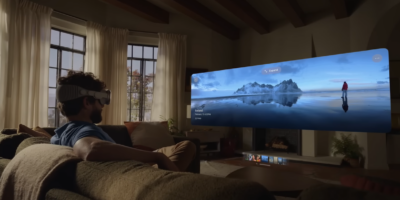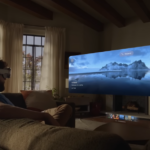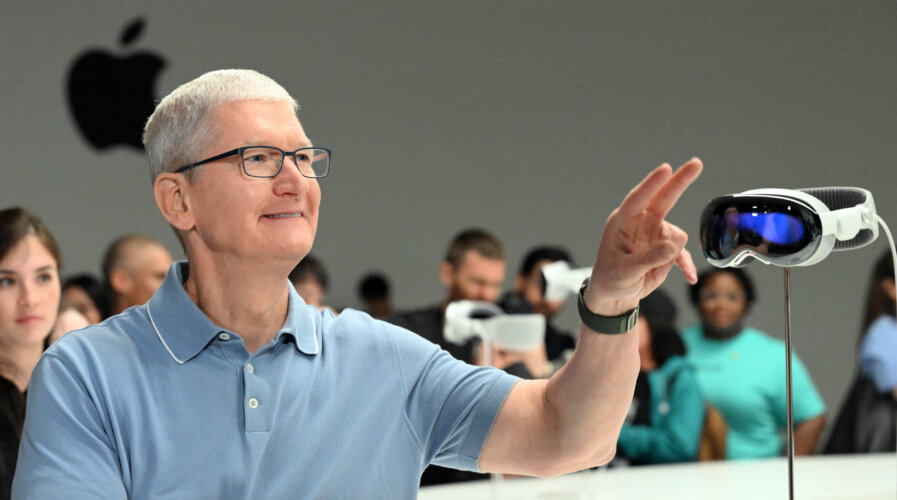
Based on S&P analysis, Apple will spearhead the AR/VR market’s next push into the mainstream.(Photo by Josh Edelson / AFP)
Can Apple drive the AR/VR headset market in the next five years?
|
Getting your Trinity Audio player ready... |
- Apple will spearhead the AR/VR headset market’s next push into the mainstream.
- AR/VR headset shipments are expected to increase at a 22.1% compound annual growth rate.
Augmented Reality and Virtual Reality (AR/VR) have been buzzing around for a few years now. The reality has been that AR and VR’s big, transformative uses have always been a niche. Many foresee it will take a few more years before they turn mainstream – but S&P Global Market Intelligence foresees Apple Inc to be at the forefront of the AR/VR headset revitalization.
For starters, S&P analysis estimated that there were about 39.7 million AR and VR headsets installed in consumer and commercial settings as of the end of 2022, down 1.2% from 34.2 million in 2021 as user churn outpaced slowing sales. The research firm also predicted that AR/VR headset shipments will increase substantially from 7.9 million in 2022 to 21.4 million in 2027, a 22.1% compound annual growth rate (CAGR).
Neil Barbour, associate research analyst at S&P Global Market Intelligence, reckons that the AR/VR hardware segment found a relatively low ceiling as an extension of the video game market after an initial surge in 2016 and 2017. “But a wave of new headsets hopes to find a broader market by emphasizing other popular computing tasks, such as video conferencing, web browsing, and media playback,” he added.
“Therefore, installed base growth base is expected to pick up in 2023, and over the forecast, the installed base is forecast to grow to 71.4 million,” he said, adding that the core value proposition is that AR/VR headsets can merge the portability of a smartphone with the expansive workspace of a multi-monitor setup. He finds that such a marketing message is being championed by Apple, “which has a solid track record in emerging hardware segments.”
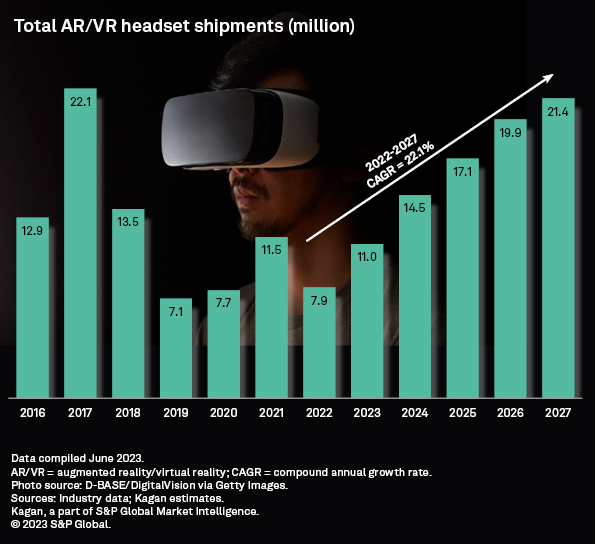
AR/VR headset installed base growth base is expected to pick up in 2023, and over the forecast, the installed base is forecast to grow to 71.4 million.
Source: S&P Global Market Intelligence
Why is Apple, not Meta, expected to champion the AR/VR headset market?
When Apple, on June 5 this year, announced that it would throw its hat into the AR/VR hardware market with the Apple Vision Pro, it was the most precise articulation yet of the idea that AR and VR are not just for gaming or niche commercial settings but can be used in daily life as one would use a laptop or a phone.
“While other VR headset vendors have incorporated or have said they were working on similar features announced for the Apple Vision Pro, Apple has a far stronger sales pitch because its hardware already commands a strong presence in users’ daily lives. Potential customers are far more likely to trust Apple in transitioning to a new computing platform as many users have already done just that over the past two decades,” S&P said in its latest research report.
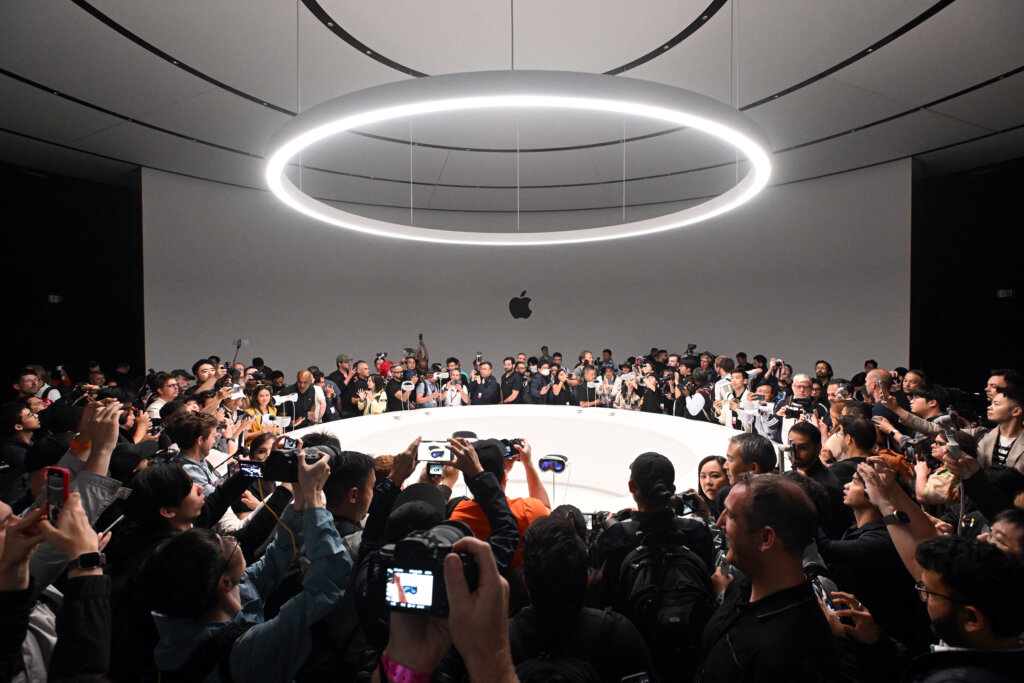
Apple unveiled its first-ever virtual reality headset challenging Facebook-owner Meta in a market that has yet to tempt users beyond video gamers and tech geeks. The release was the most significant product launch by the iconic iPhone maker since it unveiled the Apple Watch in 2015. (Photo by Josh Edelson / AFP)
S&P indicates that with Apple’s Vision Pro, AR/VR headsets will develop into a relatively approachable computing platform over the next five years as advanced pass-through cameras and a focus on productivity and communication software available the technology to a broader array of consumer personas.
“The AR/VR market’s next push into the mainstream will be spearheaded by Apple, which said it will start selling the Vision Pro in early 2024. However, Apple itself is not expected to drive substantial headset sales in 2024 as both demand and supply will be limited due to its high entry pricing of US$3,500 and high-end components, such as OLED screens,” S&P noted.
Instead, Apple will likely drive substantial buzz around the market that will benefit other entrenched vendors. Like Meta Platforms, it will help as it builds on its market-leading position with a new headset, Quest 3, later this year and a price reset on its existing hardware.
“The downside is that they will have to pay an Apple-size premium for the pleasure of being early adopters in that transition. Apple is bound to revitalize the AR/VR market, but it may take some time to find the right price-to-feature ratio to catalyze mass-market adoption,” S&P noted.
How Apple may or may not evolve in the AR/VR segment
Apple CEO Tim Cook described the headset as a way to “use your apps anywhere, any way you want,” accompanied by a video that showed the headset incorporating many of the apps with which Apple users are already familiar, such as photos, Facetime, Safari, notes, and messaging. The video also showed users in a virtual desktop setting, with access to a virtual keyboard and multiple app windows in the headset’s field of view.
“It’s probably best to think of this launch as a developer- and tech-enthusiast-focused pilot project. Apple will iterate and refine its approach to AR/VR slowly and methodically, as it does with most of its products. As key use cases become more defined, it can tweak the hardware to play to those strengths. Other features that early adopters ignore can be cut or minimized in future models to save on costs,” S&P predicts.
Overall, experts from S&P anticipate the steep price will limit sales to less than 500,000 units shipped in the first year of availability. “Apple will likely release more affordable models or, at the very least, it will continue to sharpen the value proposition to grow the installed base,” the report reads.
READ MORE
- Safer Automation: How Sophic and Firmus Succeeded in Malaysia with MDEC’s Support
- Privilege granted, not gained: Intelligent authorization for enhanced infrastructure productivity
- Low-Code produces the Proof-of-Possibilities
- New Wearables Enable Staff to Work Faster and Safer
- Experts weigh in on Oracle’s departure from adland

